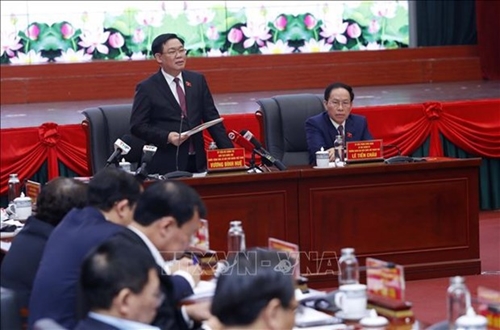During a working session with the municipal Party Committee on January 6 afternoon as part of his working trip to the city, the top legislator expressed his impression on the the remarkable 10.34% growth of the local Gross Regional Domestic Product (GRDP) index, which is nearly twice the national average.
    |
 |
|
National Assembly Chairman Vuong Dinh Hue speaks at the working session. |
According to reports presented at the working session, Hai Phong’s export turnover hit 31 billion USD, equal to 107.7% of the same period last year. Hai Phong maintained double-digit growth for nine consecutive years, and it is always among the top five localities in the provincial Competitiveness Index (PCI) rankings.
N.A. Chairman Hue applauded efforts by the municipal authorities in improving the investment and business environment, and attracting foreign investment, saying that the recent establishment off three industrial clusters has contributed significantly to creating new production motivation for the city.
He also valued the positive results the locality achieved in the fields of new-style rural building, social housing development and digitization; ensuring social security; as well as its notable progress in culture, education, health care, and scientific-technology domains.
Building and consolidating the Party and the political system has been carried out systematically and resolutely, while attention has been paid to the personnel work, he highlighted.
Agreeing with the goals, tasks, solutions as well as orientations stated in the master plan of Hai Phong to 2040 with a vision to 2050, N.A. Chairman Hue stressed that the city possesses conditions to continue sustaining breakthrough development.
He requested the municipal authorities to evaluate more thoroughly the implementation of set targets, thus rearranging goals to ensure more feasibility.
The top legislator emphasizes the need for Hai Phong to set up a rapid response force to swiftly implement tasks related to the establishment of administrative units following the urban government model and to reorganize administrative units.
Source: VNA